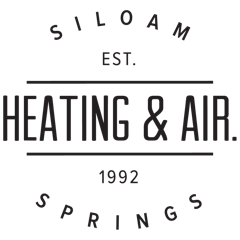
You shouldn’t have to sacrifice comfort or drain your wallet to keep your home at a refreshing temperature during summer weather.
But what is the right setting, exactly? We go over advice from energy pros so you can choose the best setting for your home.
Here’s what we suggest for the most energy-efficient setting for air conditioning in Siloam Springs.
Recommended Thermostat Settings for Summer
Most people find placing the thermostat at 72-73 degrees is ideal. However, if there’s a major difference between your indoor and exterior temperatures, your electrical bills will be bigger.
This is our advice based on the U.S. Department of Energy (DOE) and ENERGY STAR®.
While at home: 78 degrees. While that seems warm, there are ways you can keep your home pleasant without having the AC running constantly.
Keeping windows and window treatments closed during the day keeps cool air where it should be—within your home. Some window treatments, such as honeycomb shades or plantation shutters, are made to deliver extra insulation and improved energy savings.
If you have ceiling fans in your house, the DOE says you can increase thermostat temperatures about 4 degrees warmer without sacrificing comfort. That’s because they cool through a windchill effect. Because they cool people, not spaces, switch them off when you move from a room.
If 78 degrees still appears too warm on the surface, try running an experiment for approximately a week. Get started by raising your temperature to 78 degrees while you’re at your residence. Then, gradually lower it while using the advice above. You may be amazed at how cool you feel at a higher temperature setting.
While away: 88 degrees. There’s no need to keep the AC running all day while your house is vacant. Switching the setting 7–10 degrees warmer can save you anywhere from 5–15% on your electricity costs, according to the DOE.
When you arrive home, don’t be tempted to set your thermostat under 78 to cool your home more quickly. This isn’t effective and often leads to a more expensive cooling expense.
A programmable thermostat is a useful approach to keep your settings under control, but you have to set programs. If you don’t use programs, you might forget to increase the set temperature when you go.
If you need a hassle-free solution, consider installing a smart thermostat. This thermostat works with with your phone, so it is aware when you’re at your residence and when you’re out. Then it intuitively modifies temperature settings for the biggest savings. How much exactly? Typically $180 annually on heating and cooling, according to ENERGY STAR.
Another benefit of installing a smart thermostat? You can use your phone to monitor and change temperature settings from almost anywhere.
While sleeping: Around 70 degrees. While ENERGY STAR advises 82 degrees, that may be too uncomfortable for the majority of families. Many people sleep better when their sleeping space is chilled, so that’s why the National Sleep Foundation advises 60–67 degrees. But that could be too cool, due to your clothing and blanket preference.
We recommend running a comparable test over a week, putting your temp higher and gradually decreasing it to pinpoint the ideal temperature for your family. On mild nights, you could find keeping windows open at night and relying on a ceiling fan is a preferable solution than running the air conditioner.
More Methods to Conserve Energy During Hot Weather
There are other methods you can spend less money on air conditioning bills throughout warm weather.
- Get an energy-efficient air conditioning system. Central air conditioners only work for about 12–15 years and become less efficient as they age. An updated air conditioner can keep your house more comfortable while keeping utility expenses down.
- Set regular air conditioner tune-ups. Routine air conditioner maintenance keeps your equipment working like it should and might help it run more efficiently. It could also help lengthen its life expectancy, since it helps techs to discover small troubles before they lead to a major meltdown.
- Switch air filters frequently. Read manufacturer instructions for replacing your air filter. A dusty filter can result in your system short cycling, or turn on and off too much, and raise your electricity.
- Check attic insulation levels. Nearly 90% of homes in the USA don’t have adequate insulation, according to the Insulation Institute. The majority of southern climates should have 13–14” of attic insulation, while northern climates require 16–18”.
- Have your ductwork checked. Ductwork that has separated over time can seep conditioned air into your attic, walls or crawl space. This can create major comfort troubles in your home, like hot and cold spots.
- Seal holes, doors and windows. Keep humid air in its place by plugging holes. You can also caulk or weather strip doors to seal more conditioned air indoors.
Conserve More Energy During Hot Weather with Siloam Springs Heating & AC
If you are looking to use less energy during warm weather, our Siloam Springs Heating & AC experts can help. Reach us at 479-448-2261 or contact us online for additional information about our energy-saving cooling options.


